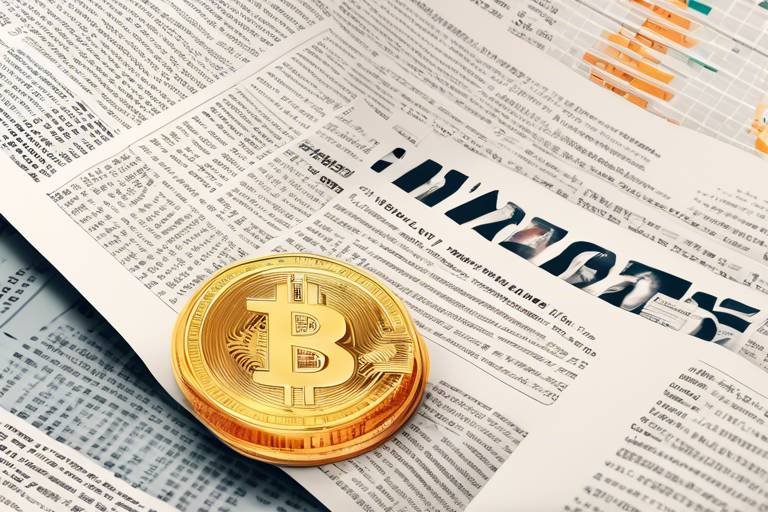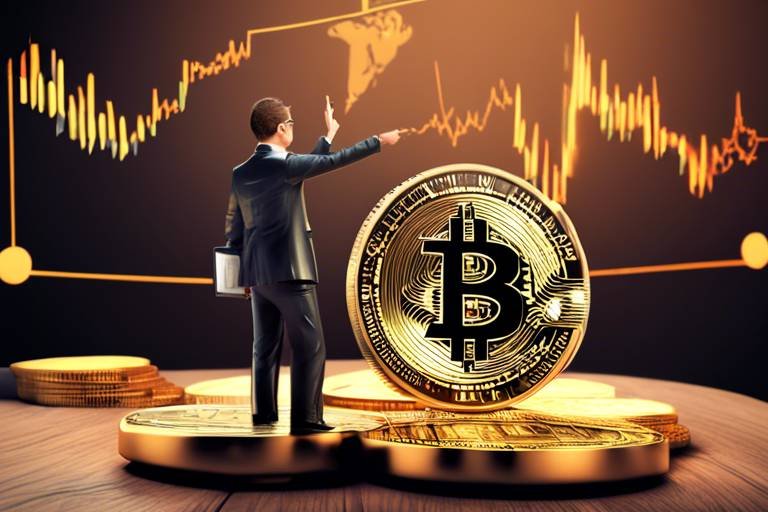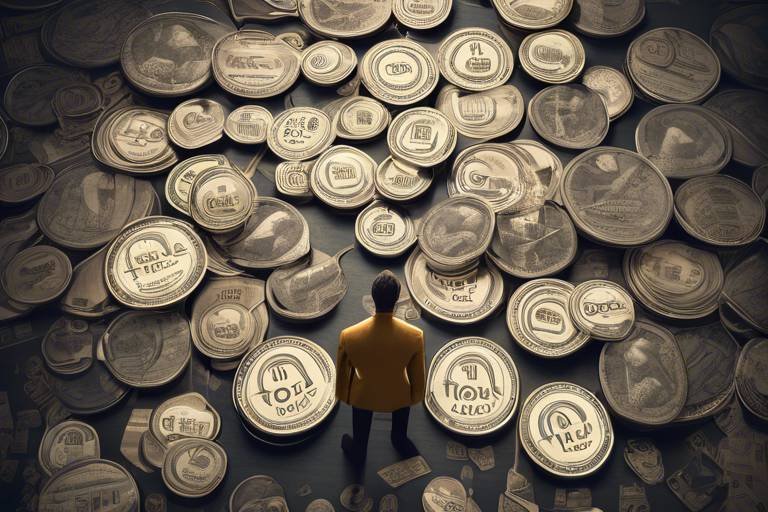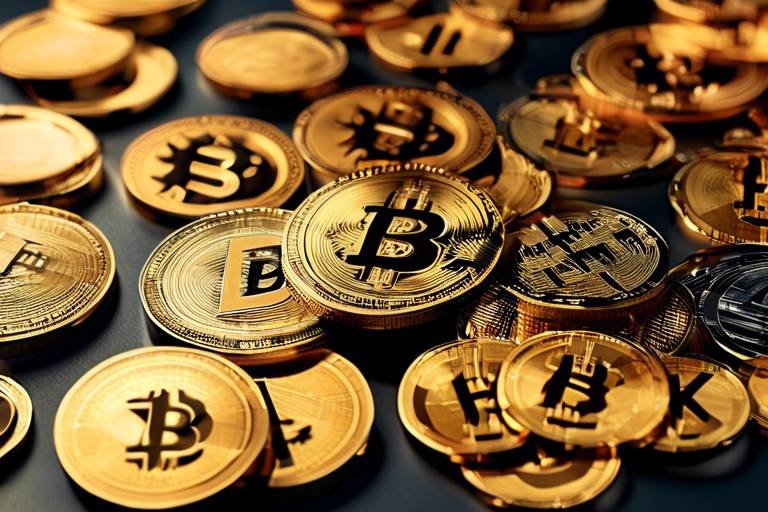Understanding the Impact of Economic Indicators on Crypto
In today's fast-paced financial world, the relationship between traditional economic indicators and cryptocurrency markets is more significant than ever. As cryptocurrencies gain traction, understanding how factors like inflation rates, interest rates, and GDP growth influence these digital assets becomes crucial for investors and enthusiasts alike. This article aims to unravel the intricate web connecting economic indicators to the crypto landscape, shedding light on how they shape investor behavior and market trends.
Inflation is a term that often sends shivers down the spine of investors, and for good reason. When inflation rates rise, the purchasing power of fiat currencies diminishes, prompting investors to seek refuge in alternative assets. This phenomenon has led many to consider cryptocurrencies as a hedge against inflation. As the cost of living increases, individuals look for ways to preserve their wealth, and crypto, with its decentralized nature and limited supply, often becomes an attractive option.
For instance, when inflation spikes, we often see a surge in demand for cryptocurrencies like Bitcoin and Ethereum. Investors flock to these digital assets, believing they can offer better returns than traditional investments. This shift in demand can significantly impact market dynamics, leading to price increases and heightened volatility. It's a classic case of supply and demand at play, where the allure of a hedge against inflation can drive crypto prices to new heights.
Interest rates are another critical economic indicator that can make or break investment decisions in the crypto sphere. When central banks adjust interest rates, it sends ripples through the financial markets, affecting everything from stocks to bonds—and yes, cryptocurrencies too. Generally, lower interest rates encourage borrowing and investing, leading to more capital flowing into riskier assets like cryptocurrencies. Conversely, when rates rise, the cost of borrowing increases, and investors may retreat to safer investments.
The decisions made by central banks regarding monetary policy can have profound implications for the crypto market. For instance, when a central bank signals a potential rate hike, it often leads to a sell-off in risk assets, including cryptocurrencies. Investors may panic, fearing that higher interest rates will stifle economic growth, leading to reduced demand for digital currencies. This reaction can create a domino effect, impacting liquidity and investment strategies across the board.
On the flip side, quantitative easing (QE) can inject significant liquidity into the markets. When central banks engage in QE, they purchase large amounts of government securities, effectively lowering interest rates and encouraging spending. This influx of capital often finds its way into the crypto markets, as investors seek higher returns on their investments. The result? A speculative frenzy where investors chase after the next big crypto opportunity, sometimes leading to unsustainable price surges.
When central banks decide to raise interest rates, the crypto markets often react with volatility. Investors may panic-sell, fearing that higher rates will lead to a downturn in the broader economy. This can trigger a market correction, where prices plummet in a short period. For long-term investors, these corrections can be painful, but they also present opportunities to buy at lower prices. Understanding this dynamic is essential for navigating the crypto landscape during such tumultuous times.
Employment statistics are not just numbers on a report; they are vital indicators of economic health and consumer confidence. High employment rates typically correlate with increased consumer spending, which can positively impact investment in cryptocurrencies. When people feel secure in their jobs, they are more likely to invest in speculative assets like crypto. Conversely, rising unemployment can lead to a more cautious approach, with investors pulling back on riskier investments.
Gross Domestic Product (GDP) growth serves as a barometer for economic health. When GDP is on the rise, it often signals a thriving economy, which can bolster crypto investments. Investors tend to feel more optimistic and are more willing to allocate funds toward cryptocurrencies during periods of strong economic performance. This optimism can lead to increased trading volumes and higher prices in the crypto market.
Understanding the correlation between GDP growth and traditional assets is crucial for gauging crypto's performance. Historically, periods of strong GDP growth have been associated with bullish trends in both traditional markets and cryptocurrencies. Investors can use this information to adjust their strategies, taking advantage of favorable economic conditions to maximize their returns.
Global events, such as financial crises or geopolitical tensions, can sway GDP and, consequently, the cryptocurrency markets. During uncertain times, investors often flock to safe havens, which can lead to increased volatility in crypto prices. It's fascinating how the interconnectedness of our global economy means that a crisis in one part of the world can have ripple effects on digital currencies. Understanding these dynamics can help investors make informed decisions, even in turbulent times.
- How do inflation rates affect cryptocurrency prices?
Rising inflation often leads investors to seek alternative assets like cryptocurrencies, increasing demand and potentially driving up prices. - What role do interest rates play in crypto investment?
Interest rates influence borrowing costs and investor sentiment. Lower rates can boost crypto investments, while higher rates may lead to sell-offs. - How do central bank policies impact the crypto market?
Decisions made by central banks regarding interest rates and monetary policy can create significant market reactions, affecting liquidity and investor strategies. - What is the relationship between GDP growth and cryptocurrencies?
Strong GDP growth generally correlates with increased investor confidence and can lead to higher investments in cryptocurrencies.

The Role of Inflation Rates
Inflation is like that uninvited guest at a party who just won’t leave; it can disrupt the atmosphere and change the dynamics of the environment. In the world of finance, rising inflation rates can significantly affect the valuation of assets, including cryptocurrencies. When inflation rises, the purchasing power of fiat currencies declines, prompting investors to seek alternative assets that can potentially offer better returns than traditional investments. In this context, cryptocurrencies often emerge as a popular choice. Why? Because they are perceived as a hedge against inflation, much like gold has been for centuries.
As inflation rates climb, many investors begin to feel the pinch in their wallets. They might start asking themselves, "How can I protect my wealth?" This question often leads them to explore the digital currency landscape, where assets like Bitcoin and Ethereum are seen as viable alternatives. The relationship between inflation and crypto demand is not just a passing trend; it’s a fundamental shift in how investors view value preservation. As more people flock to cryptocurrencies during inflationary periods, the demand surges, driving prices up. This can create a feedback loop where rising prices attract even more investors, further inflating the market.
To illustrate this relationship, let’s look at a simplified table that outlines how inflation impacts different asset classes:
| Asset Class | Impact of Rising Inflation |
|---|---|
| Fiat Currency | Decreased purchasing power |
| Real Estate | Potential for price increases |
| Gold | Traditionally seen as a safe haven |
| Cryptocurrencies | Increased demand as a hedge |
Additionally, it’s important to note that inflation doesn’t just affect the demand for cryptocurrencies; it also influences investor psychology. As inflation rises, fear and uncertainty can take hold, leading to increased volatility in the markets. Investors may become more speculative, driving prices up and down based on news cycles and macroeconomic indicators. This creates an environment where cryptocurrencies can experience dramatic price swings, often catching investors off guard.
In summary, inflation rates play a crucial role in shaping the cryptocurrency landscape. When inflation rises, it often leads to a shift in investor behavior, with many turning to crypto as a hedge against declining purchasing power. The interplay between inflation, demand, and market psychology creates a dynamic environment that investors must navigate carefully. Understanding these influences can be the key to making informed decisions in the ever-evolving world of digital currencies.
- How does inflation affect cryptocurrency prices? Rising inflation typically leads to increased demand for cryptocurrencies as investors seek to protect their wealth, often driving prices higher.
- Are cryptocurrencies a good hedge against inflation? Many investors view cryptocurrencies as a potential hedge against inflation due to their limited supply and decentralized nature.
- What other factors influence cryptocurrency markets? Besides inflation, factors like interest rates, employment data, and global economic events also play significant roles in shaping market dynamics.

Interest Rates and Crypto Markets
When it comes to investing, interest rates are like the weather—sometimes sunny, sometimes stormy, but always affecting how we plan our financial journeys. In the world of cryptocurrencies, shifts in interest rates can create ripples that lead to significant changes in market dynamics. So, how exactly do these rates influence crypto markets? To put it simply, as interest rates rise or fall, they can either attract or repel investors from traditional markets and, by extension, the crypto space.
High interest rates often mean that borrowing costs increase, which can lead to a reduction in consumer spending and investment in riskier assets, including cryptocurrencies. When investors find that they can earn a decent return in traditional savings accounts or bonds, the allure of volatile assets like Bitcoin or Ethereum might diminish. Conversely, when interest rates are low, the cost of borrowing is cheaper, encouraging investors to seek higher returns in riskier markets, including crypto. This tug-of-war between traditional finance and digital currencies keeps investors on their toes.
Central banks hold the reins when it comes to setting interest rates, and their policies can send shockwaves through crypto markets. For instance, when a central bank decides to lower interest rates, it usually aims to stimulate economic activity. This influx of liquidity can lead to increased investment in cryptocurrencies as investors seek higher returns. On the flip side, if a central bank raises rates to combat inflation, it can lead to a tightening of liquidity. As a result, investors may pull back from crypto investments, fearing that the market could correct sharply.
One of the tools central banks use, especially during economic downturns, is quantitative easing (QE). This process involves the central bank purchasing government securities to inject money into the economy. The idea is to increase liquidity, making it easier for consumers and businesses to access funds. But what does this mean for cryptocurrencies? With more money circulating, investors often turn to crypto as a hedge against inflation, driving demand and prices higher. However, this can also lead to speculative behavior, where investors chase quick returns rather than focusing on the long-term potential of their investments.
When central banks decide to raise interest rates, the market often reacts with caution. Historically, rate hikes can lead to market corrections in the crypto space. Investors may panic, fearing that the increasing cost of borrowing will stifle economic growth and, by extension, the growth of digital currencies. During these periods, we often see a flight to safety, with investors reallocating their funds into more stable assets. This reaction can create volatility in the crypto markets, leading to sharp price fluctuations that can be both alarming and exhilarating for traders.
Employment data is another critical economic indicator that intertwines with interest rates and the overall market sentiment. When job growth is strong, consumer confidence typically rises, encouraging spending and investment. In this environment, investors are more likely to take risks, including investing in cryptocurrencies. Conversely, if employment data shows a decline, it can lead to a more cautious approach, where investors might shy away from volatile assets. The relationship between employment rates and crypto investment is a complex dance that reflects the broader economic landscape.
In summary, interest rates serve as a crucial barometer for investor sentiment in the crypto markets. Understanding these dynamics can help investors make informed decisions about when to enter or exit positions. As we continue to navigate through the ever-changing financial landscape, keeping an eye on interest rates is essential for anyone looking to thrive in the world of cryptocurrency.
- How do interest rates affect cryptocurrency prices?
When interest rates rise, traditional investments become more attractive, potentially leading to a decrease in crypto demand. Conversely, lower rates can drive investors toward crypto in search of higher returns. - What role do central banks play in the crypto market?
Central banks influence interest rates through their monetary policies, which can directly impact liquidity and investment strategies in the crypto market. - How does employment data impact cryptocurrency investment?
Strong employment data typically boosts consumer confidence, encouraging investment in riskier assets like cryptocurrencies, while weak data can lead to a more cautious approach.

Central Bank Policies
The policies set by central banks are like the puppet strings of the financial world, influencing everything from inflation rates to the value of cryptocurrencies. When central banks decide to change interest rates, they are essentially sending ripples through the financial markets, including the ever-volatile crypto space. But how does this all work? Well, let's dive into the mechanics!
Central banks, such as the Federal Reserve in the United States or the European Central Bank in Europe, have a dual mandate: to ensure price stability and to promote maximum employment. When they adjust interest rates, they are trying to either stimulate the economy or cool it down. For instance, if a central bank lowers interest rates, borrowing becomes cheaper, which can lead to increased spending and investment. In this scenario, investors might look to cryptocurrencies as an alternative investment, driving up demand and prices.
Conversely, when interest rates are raised, it often results in a tightening of the financial environment. Higher interest rates mean that loans become more expensive, which can lead to decreased consumer spending and a slowdown in economic growth. This scenario can create a ripple effect in the cryptocurrency market, as investors may pull back their investments in riskier assets like crypto and shift their focus to more stable investments, such as bonds or savings accounts. The relationship between interest rates and cryptocurrency prices is not always straightforward, as various factors, including market sentiment and external economic conditions, also play significant roles.
One interesting aspect to consider is how central bank policies can affect liquidity in the crypto market. When a central bank engages in quantitative easing, for example, it injects money into the economy, increasing liquidity. This can lead to more capital flowing into alternative investments, including cryptocurrencies. Investors might feel emboldened by the availability of more cash and may be more willing to take risks, driving up crypto prices. On the other hand, when central banks tighten monetary policy, the opposite can occur, leading to a contraction in liquidity and a potential downturn in the crypto market.
In summary, central bank policies are critical in shaping the landscape of the cryptocurrency market. The decisions made by these institutions can lead to significant shifts in investor behavior and market dynamics. Understanding these policies and their implications can help investors navigate the complex world of cryptocurrencies more effectively.
- What is the role of central banks in the economy? Central banks manage monetary policy, control inflation, and stabilize the currency, influencing overall economic health.
- How do interest rate changes affect cryptocurrency? Lower interest rates can boost crypto investments, while higher rates may lead to decreased demand for riskier assets like cryptocurrencies.
- What is quantitative easing? Quantitative easing is a monetary policy where central banks purchase securities to inject liquidity into the economy, often leading to increased investments in various assets, including cryptocurrencies.
- How can I stay updated on central bank policies? Monitoring financial news outlets, central bank announcements, and economic reports can keep you informed about changes in monetary policy.

Quantitative Easing Effects
Quantitative easing (QE) is like a financial lifeboat thrown to an economy struggling to stay afloat. When central banks, such as the Federal Reserve in the United States, decide to purchase large quantities of government bonds and other securities, they inject liquidity into the financial system. This action is designed to lower interest rates and encourage lending and investment. But how does this all tie back to the world of cryptocurrencies? Well, when central banks engage in QE, it often leads to a surge in the availability of cash in the market, which can have significant implications for crypto investments.
As liquidity increases, investors may feel more inclined to take risks, pushing them toward alternative assets like cryptocurrencies. The allure of potentially higher returns can be irresistible, especially when traditional assets like bonds offer lower yields due to the artificially depressed interest rates resulting from QE. In essence, QE can create a ripple effect through the economy, where the abundance of money leads to inflated asset prices across the board, including cryptocurrencies.
Moreover, the correlation between QE and speculative behavior among investors cannot be overlooked. With more capital flowing into the markets, many individuals may start viewing cryptocurrencies as a viable investment option, often driven by the fear of missing out (FOMO). This phenomenon can lead to rapid price increases, as demand outstrips supply, creating a perfect storm for volatility. It's as if investors are playing a game of musical chairs, with crypto assets becoming the coveted chairs that everyone wants to grab before the music stops.
However, it's essential to consider the long-term implications of QE on the cryptocurrency market. While the initial effects may seem overwhelmingly positive, the sustainability of such growth is questionable. If central banks eventually decide to reverse their QE policies, often referred to as "tapering," the liquidity that fueled the crypto boom could dry up. This scenario raises a critical question for investors: Will the crypto market withstand the withdrawal of easy money, or will it face a harsh correction?
In summary, while quantitative easing can stimulate interest in cryptocurrencies by increasing liquidity and encouraging speculative investments, it also introduces a level of risk that investors must navigate carefully. Understanding this dynamic is crucial for anyone looking to invest in the ever-evolving landscape of digital currencies.
- What is quantitative easing?
Quantitative easing is a monetary policy where central banks purchase securities to increase the money supply and encourage lending and investment.
- How does QE affect cryptocurrency prices?
QE can lead to increased liquidity in the market, encouraging investors to seek higher returns in cryptocurrencies, which can drive up prices.
- What happens to crypto markets when QE is reversed?
When QE is reversed, liquidity may decrease, potentially leading to market corrections and impacting cryptocurrency prices negatively.

Rate Hikes and Market Reactions
When central banks announce rate hikes, it often sends shockwaves through financial markets, and the cryptocurrency space is no exception. Investors typically react to these changes with a mix of caution and speculation, leading to significant fluctuations in crypto prices. But why does a simple increase in interest rates have such a profound effect on digital currencies? Let's break it down.
First, it’s essential to understand that higher interest rates generally indicate a tightening of monetary policy. This means borrowing costs rise, which can lead to reduced spending and investment in traditional markets. As investors become more risk-averse, they often pull back from speculative assets, including cryptocurrencies. In fact, history shows that during periods of rate hikes, many investors prefer to move their capital into safer, more stable investments, such as bonds or stocks that pay dividends. This shift can create a domino effect in the crypto market, leading to decreased demand and lower prices.
Consider the following table that illustrates the correlation between interest rate hikes and Bitcoin's price movements over the past few years:
| Year | Interest Rate Hike (%) | Bitcoin Price Reaction |
|---|---|---|
| 2018 | 0.25 | Decreased by 20% |
| 2019 | 0.25 | Increased by 15% |
| 2020 | 0.50 | Decreased by 10% |
| 2021 | 0.25 | Increased by 30% |
This table highlights the volatile nature of cryptocurrencies, particularly Bitcoin, during periods of rising interest rates. As you can see, the reactions can vary significantly, influenced by broader market sentiment and investor psychology. For instance, while a rate hike in 2018 led to a notable decline in Bitcoin's price, the market's reaction in 2021 was much more resilient, showcasing the evolving nature of crypto investments.
Furthermore, investor sentiment during these times is often driven by fear and uncertainty. When rate hikes occur, many investors begin to question the sustainability of their crypto investments. They might wonder, “Is this the right time to hold onto my digital assets?” This uncertainty can lead to panic selling, further exacerbating price drops. On the flip side, some savvy investors might see these downturns as buying opportunities, especially if they believe in the long-term potential of cryptocurrencies. This creates a tug-of-war between bullish and bearish sentiments in the market.
In conclusion, rate hikes are a significant factor influencing crypto market reactions. As central banks adjust their policies, the ripple effects can lead to increased volatility and uncertainty in the cryptocurrency landscape. For investors, understanding these dynamics is crucial for navigating the complex relationship between traditional financial indicators and the ever-evolving world of digital currencies.
- What are interest rate hikes? Interest rate hikes refer to the increase in the cost of borrowing money, typically implemented by central banks to control inflation.
- How do rate hikes affect cryptocurrencies? Rate hikes can lead to decreased demand for cryptocurrencies as investors often seek safer, more stable investments.
- Is it a good time to invest in crypto during rate hikes? It depends on individual risk tolerance and market conditions; some investors view it as a buying opportunity, while others may sell off their assets.

Employment Data and Market Sentiment
When we talk about employment data, we're diving into a treasure trove of insights that can shape market sentiment like a sculptor molding clay. Think about it: when people have jobs, they tend to spend more money, right? This increased consumer spending can fuel economic growth, and in turn, lead to a more favorable environment for cryptocurrency investments. Conversely, when employment figures are low, it’s like throwing a wet blanket on the economy; consumer confidence dips, and so does the interest in investing in riskier assets like cryptocurrencies.
But how does this all tie back to the crypto market? Well, one key factor is investor psychology. If employment rates are rising, investors feel more secure about their financial futures. They’re more likely to take risks, including putting their hard-earned cash into digital currencies. Conversely, high unemployment rates can trigger a flight to safety, with investors gravitating toward more stable assets. This is where the emotional rollercoaster of the market comes into play.
Let’s break it down further. Here are some ways employment data influences crypto market sentiment:
- Consumer Confidence: High employment rates boost consumer confidence, leading to increased spending and investment.
- Risk Appetite: A strong job market encourages investors to take risks, making them more likely to invest in volatile assets like cryptocurrencies.
- Market Corrections: Poor employment data can lead to market corrections as investors pull back and reassess their strategies.
To illustrate this relationship, let's take a look at a hypothetical scenario. Imagine a country where the employment rate jumps from 5% to 3%. This sudden drop in unemployment could lead to a surge in consumer spending, which might reflect positively in the stock market and, subsequently, in the crypto market. Investors, feeling optimistic, might flock to Bitcoin or Ethereum, driving prices up. On the flip side, if employment rates spike to 10%, investors may panic, leading to a sell-off in crypto assets as they seek more stable ground.
In essence, employment data acts as a barometer for market sentiment. It’s not just numbers on a page; it’s a reflection of the economic climate that can sway investor behavior significantly. So, the next time you hear employment statistics being released, remember that these figures could very well be the wind in the sails of the crypto market—or a stormy cloud overhead.
Q1: How do employment rates affect cryptocurrency prices?
A1: Employment rates influence consumer confidence and spending, which can lead to increased investment in cryptocurrencies. Higher employment typically boosts prices, while lower employment may lead to market corrections.
Q2: What other economic indicators should I watch alongside employment data?
A2: It's essential to keep an eye on inflation rates, interest rates, and GDP growth, as these factors also play a significant role in shaping market sentiment and investment strategies.
Q3: Can employment data predict cryptocurrency market trends?
A3: While employment data is a vital indicator, it's just one piece of the puzzle. Other factors, such as global events and technological advancements, also significantly impact the crypto market.

The Influence of GDP Growth
Gross Domestic Product (GDP) growth is often seen as a crucial indicator of a country's economic health. When GDP is on the rise, it typically signals that businesses are thriving, consumers are spending, and overall economic conditions are favorable. But how does this relate to the world of cryptocurrency? Well, the connection is more profound than you might think. A strong GDP growth can bolster investor confidence, leading to increased investment in various assets, including cryptocurrencies. Think of GDP growth as a green light for investors; when they see it shining bright, they're more likely to venture into riskier assets like crypto.
Moreover, the relationship between GDP growth and cryptocurrency investments can be likened to a dance. As the economy grows, people feel more secure in their financial situations. They are more willing to take risks, and that often translates into higher demand for cryptocurrencies. This increased demand can lead to price surges, as more investors jump into the market, hoping to capitalize on the upward momentum. Conversely, when GDP growth slows down, fear and uncertainty can creep in, causing investors to pull back and reassess their portfolios, which can lead to a decline in crypto prices.
To better understand this relationship, let's take a look at some historical data that illustrates how GDP growth correlates with cryptocurrency investments:
| Year | GDP Growth (%) | Bitcoin Price Growth (%) |
|---|---|---|
| 2017 | 2.4 | 1300 |
| 2018 | 2.9 | -73 |
| 2020 | -3.4 | 305 |
| 2021 | 5.7 | 60 |
As you can see from the table, there are notable fluctuations in both GDP growth and Bitcoin price growth. In years where GDP growth was strong, like 2017 and 2021, Bitcoin saw substantial price increases. However, during periods of economic decline, such as in 2018 and 2020, the price of Bitcoin took a hit. This correlation suggests that investors often view cryptocurrencies as alternative investments, particularly when traditional markets seem shaky.
Additionally, global economic events can also sway GDP growth, and in turn, influence the cryptocurrency market. For instance, during times of financial crises or geopolitical tensions, GDP growth may slow down, leading to increased volatility in the crypto space. Investors may flock to cryptocurrencies as a hedge against traditional market downturns, but this can also create an unpredictable environment where prices fluctuate wildly.
In summary, understanding the influence of GDP growth on cryptocurrency markets is essential for any investor looking to navigate this complex landscape. By keeping an eye on economic indicators and recognizing how they impact investor sentiment, you can make more informed decisions about when to enter or exit the crypto market. So, the next time you hear about GDP growth, remember that it’s not just a number; it’s a signal that can shape your investment strategies in the dynamic world of cryptocurrencies.
- How does GDP growth affect cryptocurrency prices?
GDP growth often leads to increased investor confidence, which can drive up demand for cryptocurrencies. - What happens to cryptocurrencies during economic downturns?
During economic downturns, investors may pull back from riskier assets, including cryptocurrencies, leading to price declines. - Can global events impact GDP and cryptocurrency markets?
Yes, global events such as financial crises or geopolitical tensions can affect GDP growth and subsequently sway cryptocurrency prices.

Correlation with Traditional Assets
When we talk about the correlation between cryptocurrencies and traditional assets, we're diving into a fascinating world where digital currencies like Bitcoin and Ethereum interact with more established financial instruments such as stocks, bonds, and commodities. Understanding this relationship is crucial for investors looking to navigate the often turbulent waters of the crypto market. Just like a dance where each partner influences the other's moves, cryptocurrencies and traditional assets can either amplify or dampen each other's performance based on various economic factors.
Historically, many investors have viewed cryptocurrencies as a hedge against traditional market volatility. For instance, during times of economic uncertainty or stock market downturns, some investors flock to crypto as a safer haven, believing that digital currencies can retain value when traditional assets falter. This behavior can lead to a positive correlation between the two asset classes during certain periods, especially when traditional markets are under stress.
To illustrate this correlation, let’s take a look at a simplified table that highlights the performance of cryptocurrencies versus traditional assets during a recent market downturn:
| Asset Class | Performance (%) | Time Period |
|---|---|---|
| Bitcoin | +15% | March 2020 |
| S&P 500 | -10% | March 2020 |
| Gold | +5% | March 2020 |
This table shows that while the S&P 500 struggled, Bitcoin managed to soar, highlighting its potential as a diversification tool in an investor's portfolio. However, it’s crucial to note that this correlation isn’t always stable. During periods of economic recovery, the relationship can flip, with cryptocurrencies behaving more like volatile tech stocks, leading to a negative correlation with traditional assets.
Moreover, the influence of macroeconomic factors cannot be overlooked. For example, interest rate changes can affect both asset classes. When interest rates rise, traditional assets may become more attractive due to higher yields, potentially leading to a decrease in crypto investments. Conversely, when rates are low, investors might seek higher returns in the crypto market, driving prices up. This dynamic behavior creates a push and pull effect that investors must keep in mind.
Ultimately, understanding the correlation between cryptocurrencies and traditional assets is not just about observing trends; it’s about strategically positioning oneself in the market. Investors should continuously monitor economic indicators and market sentiment to make informed decisions. Just like a seasoned sailor adjusting their sails to the changing winds, successful investors adapt their strategies based on the evolving relationship between these asset classes.
- What is the primary factor influencing the correlation between cryptocurrencies and traditional assets?
The primary factors include economic indicators such as interest rates, inflation, and overall market sentiment. - Can cryptocurrencies replace traditional assets entirely?
While cryptocurrencies offer unique benefits, they are unlikely to replace traditional assets due to their inherent volatility and regulatory challenges. - How can investors use the correlation to their advantage?
Investors can use the correlation to diversify their portfolios, hedge against risks, and identify opportunities based on market conditions.

Global Economic Events
Global economic events, such as financial crises, geopolitical tensions, and pandemics, can significantly influence the cryptocurrency markets. These events often create an atmosphere of uncertainty that leads investors to reconsider their strategies. For instance, during a financial crisis, traditional markets may falter, prompting investors to seek refuge in alternative assets like cryptocurrencies. The volatility inherent in these digital currencies can be both a risk and an opportunity, depending on how investors interpret the unfolding economic landscape.
Take the COVID-19 pandemic as a prime example. When the world went into lockdown, traditional markets experienced unprecedented declines. In contrast, many cryptocurrencies saw a surge in interest and investment. This was partly due to the increased liquidity provided by government stimulus packages, which led individuals to explore alternative investment avenues. The pandemic highlighted a crucial aspect of crypto: it thrives in times of uncertainty, often seen as a hedge against traditional economic downturns.
Moreover, geopolitical tensions can also sway cryptocurrency prices. For instance, when tensions rise between major economies, it often leads to fluctuations in fiat currencies, which can drive investors towards cryptocurrencies. The decentralized nature of crypto offers a sense of security that traditional currencies may not provide during turbulent times. Investors might feel that holding digital assets can protect them from governmental policies that could devalue their local currency.
To illustrate the impact of global events on cryptocurrency markets, consider the following table that outlines some significant events and their effects on crypto prices:
| Event | Date | Effect on Crypto |
|---|---|---|
| COVID-19 Pandemic | March 2020 | Initial drop followed by a surge as investors sought alternatives |
| US-China Trade War | 2018-2020 | Increased volatility in markets, leading to higher interest in Bitcoin |
| Russia-Ukraine Conflict | 2022 | Spike in Bitcoin prices as investors fled to safety |
As we navigate through these global economic events, it becomes clear that the relationship between traditional markets and cryptocurrencies is complex and dynamic. Investors must remain vigilant and informed, as the outcome of these events can create both challenges and opportunities in the crypto space. Understanding how these global occurrences affect market sentiment can empower investors to make more informed decisions, ultimately leading to better investment outcomes.
- How do global events affect cryptocurrency prices?
Global events can create uncertainty, prompting investors to move towards cryptocurrencies as a safe haven, which can drive prices up. - What role does government policy play in cryptocurrency investment?
Government policies, especially during economic crises, can influence liquidity and investor behavior, affecting cryptocurrency demand. - Are cryptocurrencies a good hedge against economic downturns?
Many investors view cryptocurrencies as a hedge against traditional market downturns, especially during times of high uncertainty.
Frequently Asked Questions
- How do inflation rates affect cryptocurrency prices?
Inflation rates can significantly impact cryptocurrency prices. When inflation rises, traditional currencies may lose purchasing power, prompting investors to seek alternative assets like cryptocurrencies. This shift in demand can lead to increased prices for digital currencies as more people look for a hedge against inflation.
- What role do interest rates play in the crypto market?
Interest rates are crucial in shaping investment decisions. When interest rates rise, borrowing costs increase, which can lead to a decrease in investment in riskier assets like cryptocurrencies. Conversely, lower interest rates can encourage more investment in crypto as investors seek higher returns compared to traditional savings.
- How do central bank policies influence cryptocurrency?
Central bank policies, particularly regarding interest rates and quantitative easing, have a direct impact on liquidity in the market. When central banks implement policies that increase liquidity, it can lead to more investment in cryptocurrencies as investors look for higher returns. However, rate hikes can cause market corrections, affecting crypto prices negatively.
- What is the effect of employment data on crypto investment?
Employment data serves as a key economic indicator that influences consumer confidence. High employment rates often boost confidence, leading to increased investment in various assets, including cryptocurrencies. Conversely, poor employment statistics can create uncertainty, causing investors to be more cautious and possibly pull back from crypto investments.
- How does GDP growth correlate with cryptocurrency performance?
Strong GDP growth typically indicates a healthy economy, which can bolster investor confidence in all markets, including cryptocurrencies. When GDP is growing, investors are more likely to take risks and invest in crypto, believing in its potential for high returns. Understanding this correlation can help investors make informed decisions about their crypto portfolios.
- What global events can impact cryptocurrency markets?
Global events, such as financial crises, geopolitical tensions, or significant economic shifts, can heavily influence cryptocurrency markets. During times of uncertainty, investors may flock to cryptocurrencies as a safe haven, or they may withdraw from the market altogether, leading to volatility. Keeping an eye on global events is essential for anyone involved in crypto investment.


















